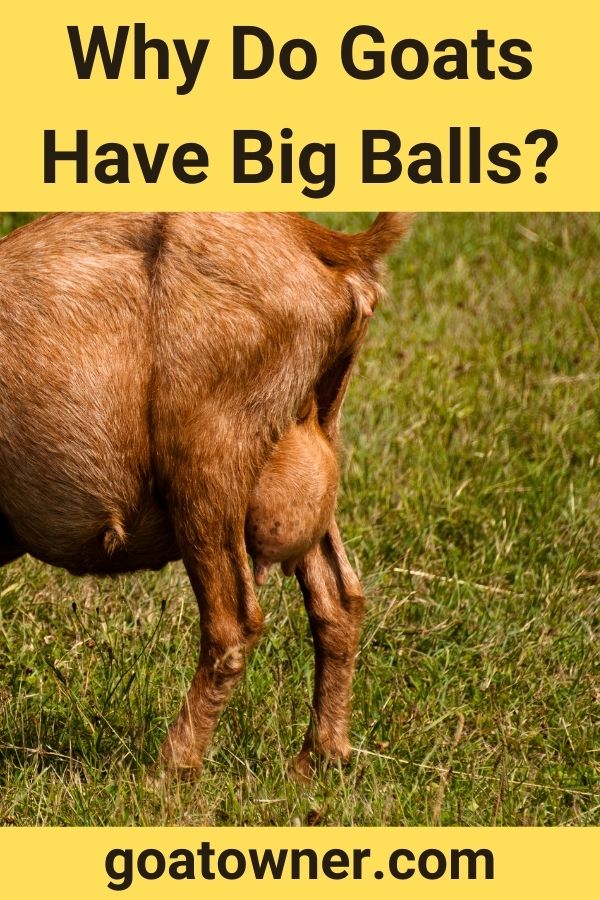Goats’ balls are big because goats are herd animals, and a single buck in the wild may be expected to mate with many females.
For this, they need large testicles that can produce a lot of sperm to impregnate as many females as possible.
Let’s look further into this.
Why do goats’ balls get so big?
There’s a really very simple reason: reproduction.
Firstly, let’s remind ourselves of some basic biology facts.
One of the central parts of any organism’s life is reproducing, having offspring, and ensuring the continued survival of its own species.
This is an instinct basic to literally all life.
Goats are herd animals.
In most wild herds, there will not be many males.
At the very least, the ration of females to males will be highly skewed towards females.
This is how many herd animals operate.
For a buck, then, who alone presides over a veritable harem of does, virulence is going to be a big problem.
If they aren’t virile enough, they aren’t going to be able to maximise their reproductive strategy.
So, this is the reason goat’s balls get so big.
As the goat gets older, it becomes more and more sexually mature.
At an older age, it is also more likely to be able to place itself at the head of a herd.
As I said, the bigger a goat’s balls are, the more semen it can produce.
The more semen it can produce, the more females it can impregnate and the more offspring it can have.
But you’ve got to be careful that their balls aren’t actually swollen.
Why are my goat’s balls swollen?
There are many possible reasons your goat’s balls could be swollen, rather than just naturally big.
They will usually look a lot redder, and your goat will show signs of illness and fatigue.
Swelling can be caused by external injury to the testicles themselves.
This can be a big problem for goat’s with large balls.
It can also be caused by infection and disease processes, even heart failure.
Surface issues are the most common factors, though—things like mange, frostbite, and callusing.
If you think your goat’s balls may be swollen, your best bet is to call the vet.
You can use something cold to soothe the pain, but don’t use ice—this will be too cold.
The vet will be able to accurately diagnose the problem and prescribe proper treatment.
| Related Articles |
|---|
What is a cryptorchid goat?
One case that may lead to goats having quite small testicles is being what’s known as a cryptorchid.
This means that the testicles have not completely descended during adolescence, and it can happen to either one—though it seems to be more common with the left testicle.
Other studies have shown it is equally common for both, though.
So, for some goats, there are problems that can occur with the descent of the testicles.
This is due, in part, to selective breeding by us.
We naturally want goats that are highly virile, so we selectively breed goats with larger testicles.
Over time, this had led to higher instances of cryptorchidism in goats.
That said, it still isn’t especially common.
A common question, though, is whether it is safe to breed such goats if only one testicle has properly descended.
Can a goat with one testicle breed?
The short answer is no.
These goats should not be bred, and it’s also very difficult to castrate them.
This makes rearing them a challenge, as they can’t really be sold as pets or breeders.
If your goat has only one testicle, then, you should consult a vet about any procedures which may be able to help.
If you catch the problem early on, the vet may be able to prescribe treatment or even surgery to correct the problem.
After a certain point, though, you won’t be able to do much for it.
Again, this will make the goat difficult to sell and virtually impossible to breed.
Your goat’s balls, then, are simply all about sperm production.
Nature is often not as simple as we expect, but in this issue, it sort of is.
The bigger a goat’s balls, the more sperm it can produce, and the more offspring it will have.
The more offspring an individual has had, the more ‘successful’ it has been as an organism.
Goat’s balls get bigger as they get older and more sexually mature—just be sure they aren’t actually swollen!

